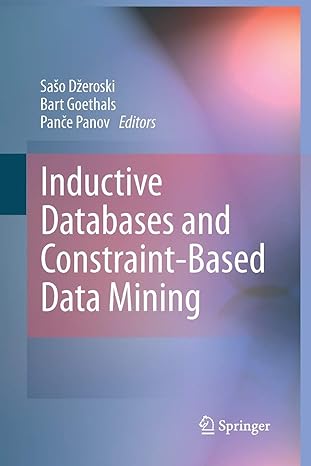Question
S is defined as the set of all RNA strands, strings made of the bases in B = {A, U, G, C}. Define the functions
S is defined as the set of all RNA strands, strings made of the bases in B = {A, U, G, C}. Define the functions mutation, insertion, and deletion as described by the pseudocode below: 1 procedure mutation(b1 bn : a RNA strand , k : a positive integer , b : an element of B ) 2 fo r i := 1 to n 3 i f i = k 4 ci := b 5 e l s e 6 ci := bi 7 return c1 cn {The return value is a RNA strand made of the ci values} 1 procedure insertion(b1 bn : a RNA strand , k : a positive integer , b : an element of B ) 2 i f k > n 3 fo r i := 1 to n 4 ci := bi 5 cn+1 := b 6 e l s e 7 for i := 1 to k 1 8 ci := bi 9 ck := b 10 fo r i := k + 1 to n + 1 11 ci := bi1 12 return c1 cn+1 {The return value is a RNA strand made of the ci values} 1 procedure deletion(b1 bn : a RNA strand , k : a positive integer ) 2 if k > n 3 m:= n 4 for i := 1 to n 5 ci := bi 6 e l s e 7 m := n 1 8 fo r i := 1 to k 1 9 ci := bi 10 fo r i := k to n 1 11 ci := bi+1 12 return c1 cm {The return value is a RNA strand made of the ci values} For this question, we will use the following predicates. FA with domain S is defined recursively by: Basis step: FA(A) = T, FA(C) = FA(G) = FA(U) = F Recursive step: If s S and b B, then FA(sb) = FA(s) PAUC with domain S is defined as the predicate whose truth set is the collection of RNA strands where the string AUC is a substring (appears inside s, in order and consecutively) L with domain S Z
+ is defined by, for s S and n Z +,
L(s, n) = (
T if rnalen(s) = n F otherwise Mut with domain S S is defined by, for s1 S and s2 S,
Mut(s1, s2) = k Z
+b B( mutation(s1, k, b) = s2 )
Ins with domain S S is defined by, for s1 S and s2 S,
Ins(s1, s2) = k Z
+b B( insertion(s1, k, b) = s2 )
Del with domain S S is defined by, for s1 S and s2 S,
Del(s1, s2) = k Z
+( deletion(s1, k) = s2 ) 9
(a) Which of the following is true? (Select all and only that apply.) i. FA(AA) ii. FA(AC) iii. FA(AG) iv. FA(AU) v. FA(CA) vi. FA(CC) vii. FA(CG) viii. FA(CU) (b) Which of the following is true? (Select all and only that apply.) i. s S n Z
+ (L(s, n))
ii. s S n Z
+ (L(s, n))
iii. n Z
+ s S (L(s, n))
iv. s S n Z
+ (L(s, n))
v. n Z
+ s S (L(s, n))
vi. s S n Z
+ (L(s, n))
(c) Which of the following is true? (Select all and only that apply.) i. s S Mut(s, s) ii. s S Mut(s, s) iii. s S Ins(s, A) iv. s S Ins(A, s) v. s S Del(s, A) vi. s S Del(s, A)
Step by Step Solution
There are 3 Steps involved in it
Step: 1

Get Instant Access to Expert-Tailored Solutions
See step-by-step solutions with expert insights and AI powered tools for academic success
Step: 2

Step: 3

Ace Your Homework with AI
Get the answers you need in no time with our AI-driven, step-by-step assistance
Get Started


